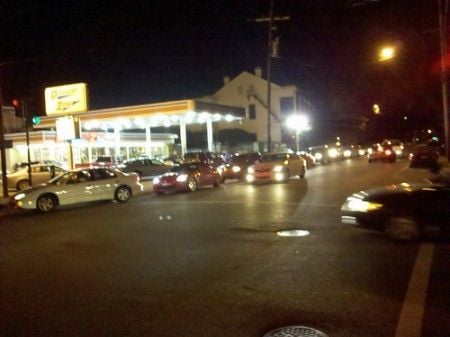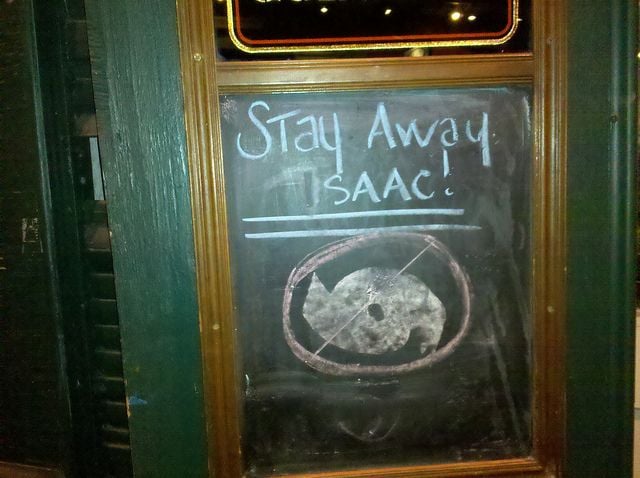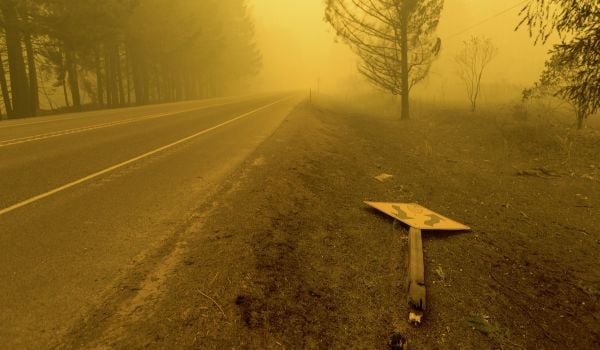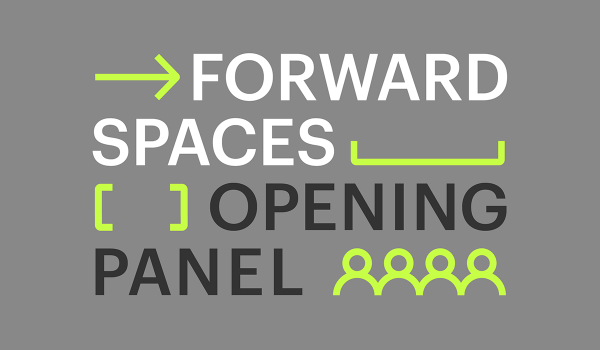Roy Bradley stood at the corner of St. Claude Avenue and Flood Street in New Orleans’ Lower 9th Ward on Monday afternoon, waiting outside of St. Maurice Grocery and Used Tires. Bradley, 43, was getting a flat repaired as he prepared to drive his wife, mother-in-law and two daughters to Baton Rouge before Hurricane Isaac makes landfall, forecast to happen late Tuesday night or early Wednesday morning.
Isaac, which the U.S. National Hurricane Center today named a Category 1, is expected to bring a six- to ten-foot storm surge on Lake Ponchatrain, the saline estuary from the Gulf of Mexico that forms the northern border of New Orleans. Floodgates near the lake, which was the site of significant flooding and a major levee failure back in 2005 during Hurricane Katrina, closed Monday evening.
Though not anticipated to be as intense as Hurricane Katrina, Isaac’s approach leaves a New Orleanian like Bradley unwilling to take any risks. When the levees on the Industrial Canal failed in 2005, Bradley’s house was inundated with 16 feet of water, one of 14,000 houses in the Lower 9th annihilated by the surge. He and his family crammed into a FEMA trailer for eight months; the organization www.lowernine.org helped them rebuild their home.
“The levee was fixed on that side,” Bradley said, motioning north to where the massive levee failure occurred seven years ago, and a barge famously exploded onto the neighborhood. “But what about that side?” he asked, turning south to where the Industrial Canal meets the Mississippi River.
In addition to stirring up memories of Katrina’s devastation, Isaac will prove the largest test of the updated levee system — $14 billion has been invested into improving it — since the 2005 storm.
The oncoming storm is also a test for Mayor Mitch Landrieu, who was elected in 2010 with a broad mandate to reform the city’s legendarily dysfunctional bureaucracy and modernize its infrastructure, including emergency communication systems and transit systems necessary for evacuation proceedings.

Credit: Flickr user skooksie
So far, Landrieu appears to be winning the confidence of colleagues in government as well as residents who say his improvements, such as upgrades to the city’s 311 system, are helping keep panic levels low. In stark contrast to his predecessor Ray Nagin, who had a skittish relationship to the public throughout his two terms in office — including, infamously, during Katrina — Landrieu has maintained clear and consistent communication throughout the buildup to the storm, with his staff live-tweeting press conferences and issuing emergency warnings in Spanish and Vietnamese.
On Monday afternoon, more than 150 AT&T utility trucks were parked on high ground at the foot of Audubon Park and poised to make utility repairs after the winds die down below 30 milers per hour. “We’re in the game, we’re in the front, and guess what? We’re on the front line,” Landrieu said at a press conference midday Tuesday, as rain and high winds began to bear down on the city.
“I feel the most confident I have ever felt in any storm during my lifetime in New Orleans,” said Jackie Branton, vice-president of the New Orleans city council, at a press conference Monday.
Gray Graham, 56, a building inspector for the city who lives in Gentilly, sat at a picnic table on Monday next to Lake Ponchatrain with a friend visiting from Orange Country, Calif. The waters in the lake were choppy and the breezes strong. Despite the possibility of up to 16 inches of rain and storm surge over the lake, Graham said he trusts the repaired levees along the lake to hold up during the storm.
“Category One,” he said dismissively. “I was here for Katrina.”
Others share Graham’s confidence. Heading off to Baton Rouge from the Lower 9th, Roy Bradley said, “If they don’t blow the levee, we’ll be back.”

Ingrid Norton is a writer based in New Orleans and obsessed with cities. Her work has appeared in publications including The Chronicle of Higher Education, Dissent, GOOD and the Los Angeles Review of Books. She’s written on topics from the precipitous growth of Austin to arson and urban divestment in Detroit. Areas of interest include cities in literature, the criminal justice system, the developing world, immigration patterns, port cities, poverty, America’s sun and rust belts, race and urban history.
















